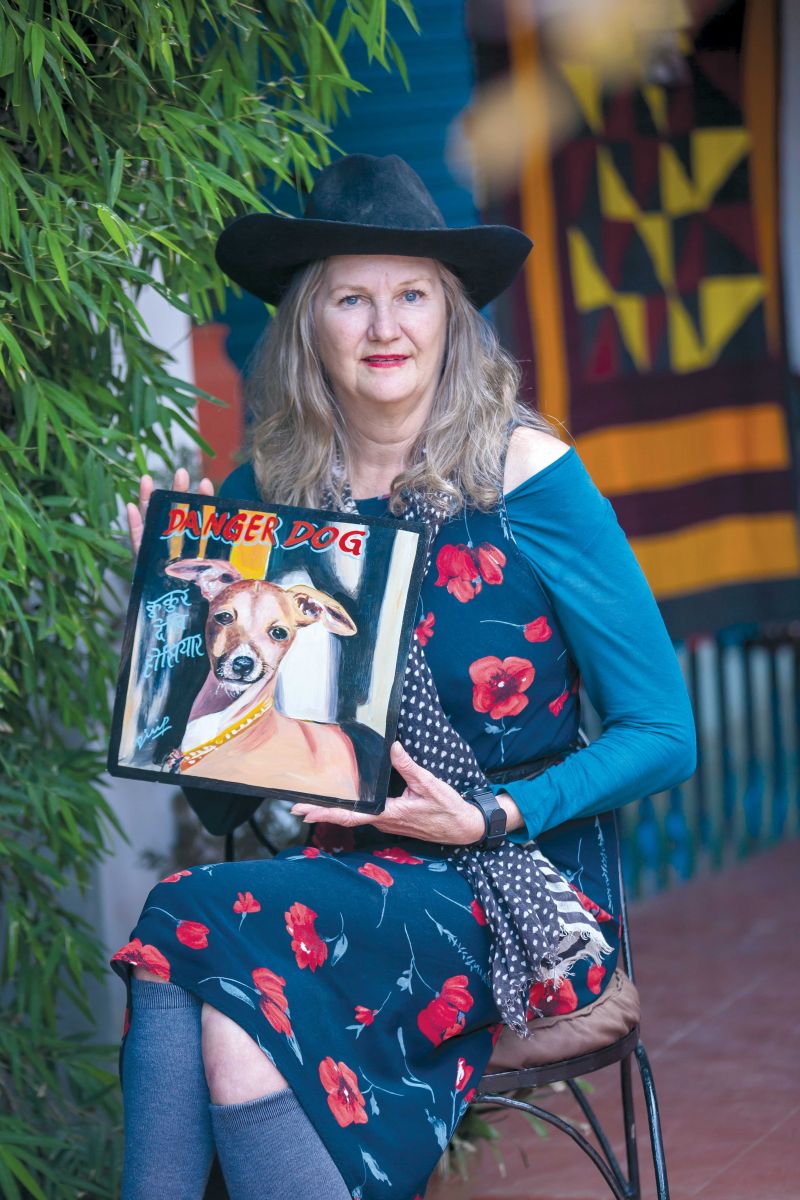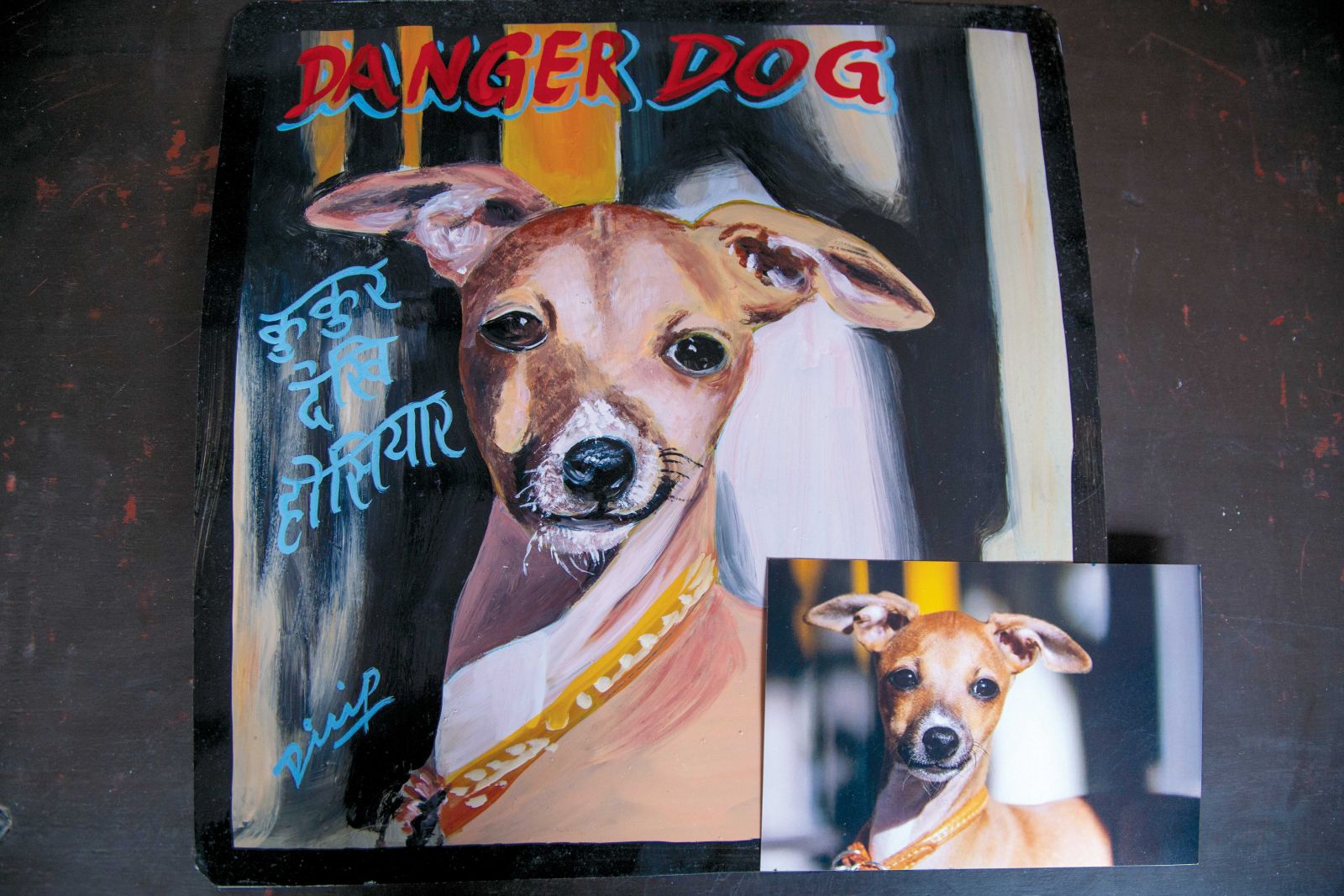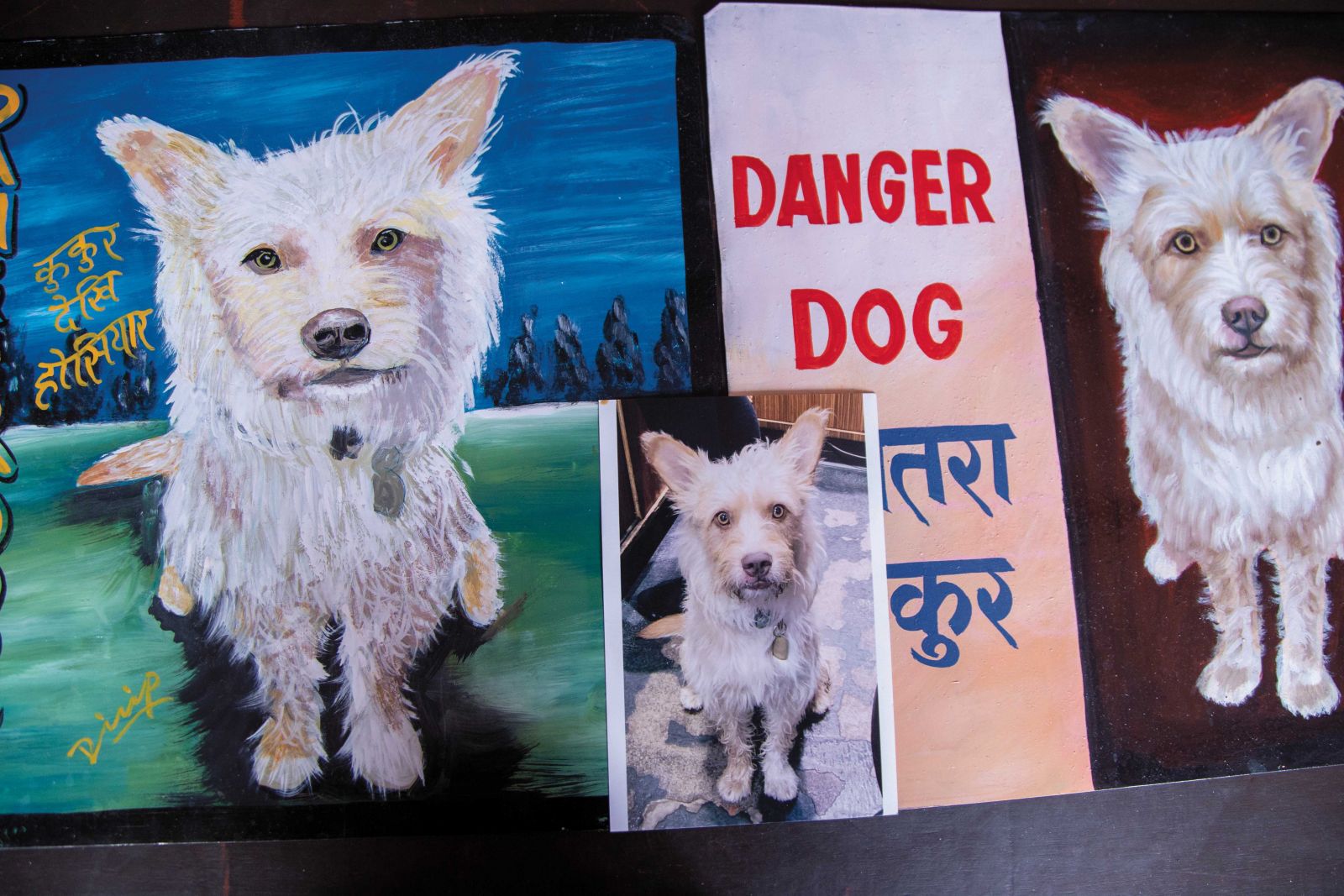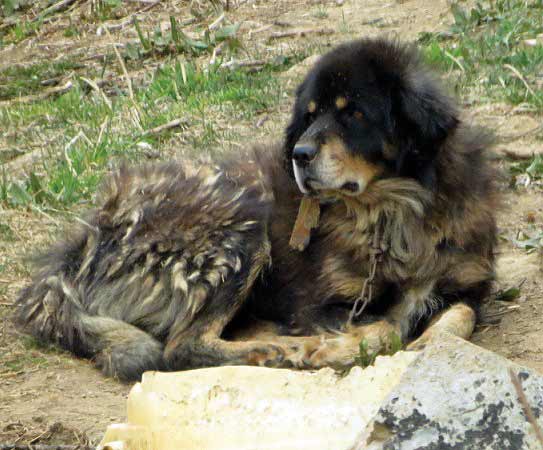
"During one of her first trips here, Michelle went to Tripureshwor and found 12 different artists in three blocks, which is an impossible prospect these days. For a long time, painting the ‘beware of dog’ signs remained a time honored tradition."
Michelle Page first came to Nepal in 1986 when the ring road in Kathmandu was encircled by green and pleasant landscape. Back then, she used to enjoy cycling from Thamel to Boudha on the scenic route surrounded by rice fields. She recalls spending six dollars a night on a hotel room in Kathmandu from where she could see the Himalayas through her windows. It was during that time that she first saw the artistic hand-painted ‘beware of dog’ signs painted on metal sheets in various places in the valley. But it was the one she saw in Mahankal road in Boudha that inspired her project. It was a traditional Nepali dog sign with a colorful portrait of a dog with a "Danger Dog" written on it. This sign was the inspiration for the “Nepal Art Dogs– Folk Art from the Himalayas” project.
Beware of Dog signs are usually a great way to make visitors aware of potential danger from dogs and also to protect your private property. But in Nepal, every dog sign was a mirror of visual culture. The signboards used to be colorful artwork, a portrait painted through the skills of a professional artist with great imagination and intrigue. Personalization and custom batches were the norm then. However, in the last 10 years, computer-generated graphics on flex have taken over and Michelle found them very ‘boring and ugly.’ So she decided to take it upon herself to promote a fair trade art project to protect a dying art form.
For 25 years, Michelle worked as a motion picture film editing assistant. Her work includes the popular Spider Man trilogy directed by Sam Raimi. She retired at 50 and started this business which she’s been doing for 13 years now. All told, she has commissioned over 3500 pieces of art in her 26 trips to Nepal. She has hired artists from all over the country—not only Kathmandu but Pokhara, Myagdi and Jomsom. These uniquely personalized works of art are done on sheets of metal, usually with synthetic enamel paint, though there are those who use acrylic paint, too. Her customers are pet lovers from all over the world who also love art and want to make a difference. They include businessmen, actors, tarot card readers and telephone operators. She has done a lot of sales at the Santa Monica Museum of Art and the Craft and Folk Art Museum in the US, too.


During one of her first trips here, she went to Tripureshwor and found 12 different artists in three blocks, which is an impossible prospect these days. For a long time, painting these signs remained a time honored tradition. If a father was an artist, his son followed him and so did the rest of the family, including brothers and uncles. But all the artists are disappearing now since painting no longer remains a means of maintaining economic self-sufficiency. Many of these artists have been migrating to foreign countries for employment—some that used to work with Michelle are now in Saudi Arabia, Malaysia, South Korea and Kuwait. The valley’s road expansion hasn’t helped either, because most artists had small shops beside the road which were demolished. A number of these artists are difficult to reach now since they have changed their numbers and residences.
Michelle met one incredible signboard artist during her trip to Myagdi. He was known for his unique style and he worked on assignments for her until, like many of his contemporaries, he went to Saudi Arabia. When Michelle returned to Myagdi many years later, she saw astonishing sign boards everywhere."I asked the locals who made them and it was the same artist. He had returned after earning some money and had started an electric shop but he continued to paint!"
A few of the artists continue to paint, but they are struggling. Some of them play chess together; others don't know each other. Almost all of them do license plates. Like Meghraj, one of the premium artists Michelle has worked with: his studio kept getting smaller, he kept on moving and now his studio is closed and he paints from home. "Nowadays, I meet him in a café for discussions." His son used to work with him, too, but it's difficult to see the younger generation continuing the tradition for much longer.
Among the many attractive new signboard paintings is Momo the cat: a painting of a long-haired Himalayan cat by the artist Dilip, a charismatic painter who has done background art work for movies and recently did a mural for a hotel.
The artists are spread across the capital so Michelle travels around by microbus to meet the artists in places like Jyatha, Boudha, Basundhara and Chabahil. She has collected up to 80 paintings in a day. Some artists take 45 minutes to make them, other take days. Every now and then when she picks them up, they are wet. She has sometimes got her hands on the paintings just 2-3 days before leaving for the United States.
Michelle knows which artist is good for what work. She is very familiar with their style. For each commission she does, she gives the same photograph of the client’s pet to three different signboard artists so that they can bring their own creativity and uniqueness to the artwork. There are different interpretations of the same photos because the artists use dissimilar techniques, hence the same photograph turns out different as paintings. Some make it with a smoother cartoonish texture while others make it more realistic, adding depth and realism to the features. Michelle strongly believes that these hand paintings should not only be appreciated but they must be financially valued too. She gives them partial payment in advance and later pays the full sum when the work is done. She gives them a raise after each trip and pays the artists five to six times what she paid earlier. Once the painting is done, she writes the date of completion on the back of the sign boards and wraps them in a Nepali newspaper. She has had orders from Australia, New Zealand, England, France, the United States, Canada, Mexico, Switzerland and Lebanon.
"It's a fair trade art project but sometimes I feel I am unfair to myself. I don't get the money upfront; if the customers don't like the art, they don't need to buy it." Generally, the pieces are approximately one foot square, on a light metal sheet, but Michelle retells a funny incident of the time one artist used such a heavy metal sheet that it was difficult even to carry and post. "It was at least 3 pounds! Earlier, old metal signs were recycled and then painted."
Every painting has a story behind it. From time to time, the story about the artwork can be more fascinating than the actual piece. The signboard paintings can be far more complicated than they appear at first glance, like the one of a dog and Lord Ganesh. A soldier left his home for his duty and his wife was alone with their dog. A burglar snuck into the house but couldn't get past the dog who alerted her, saving her life in the process. So the couple commissioned the painting of the dog with Lord Ganesh because the woman loved the Hindu god.
People want to see a personal and impressionistic view of their dogs and cats, and the artists have painted diverse breeds of dogs—from Labradoodles to Lhasa Apsos and Burmese, Siamese and Tonkinese cats, but they are not limited to dogs or cats. Paintings of sheep, oxen, parrots, pigeons, horses and dragons are all in demand. The aesthetic appeal of these paintings has even led customers to order their own portraits. The Barack Obama paintings were very popular in 2008 when he became the first African American to be elected President of the United States. 26 signboard paintings from 11 artists were commissioned and all but three sold. The signboards can be hung both indoors and out, they can be put in windows or framed. "The best ones are bought, I never see them again. They are out of sight, out of mind. Some are sold at museum shops and art galleries."
She travels to Nepal two times a year, each spring and autumn. Since Michelle and her husband travel for several months out of the year, they never had time to have dogs. But she fondly remembers the black standard poodle she had when she was five, and puts dog signs in her home in Santa Monica regardless. "I put the pit bull dog sign whenever I am out. When I am home I put out the sign with the painting of a Boston terrier. I keep on switching the signboards because I have so many options."
Michelle hopes someday she can bring some of the work back to Nepal and hold an art exhibition. She would like to encourage Nepali people to hire the artists because she believes they can do almost anything—her hope is that this unique style of artwork and the artists that produce it will take a more prominent position in popular art culture in Nepal.
To learn more and see more great works of art visit: https://nepaldog.com/
Some lesser-known vegetable dishes from the southern plains
I’m not a vegetarian but I love vegetables. And whenever I get to the southern plains of Nepal, I try...









